|
--- "Ideas, Plans and Pipe Dreams" --- As detailed in the overview, the introduction of a senior management team in 1976, under Chris Hind, was meant to presage a turn around in the future of Belle Vue and lay the foundations for a secure long term development at least that is how it was presented to the new incumbents. 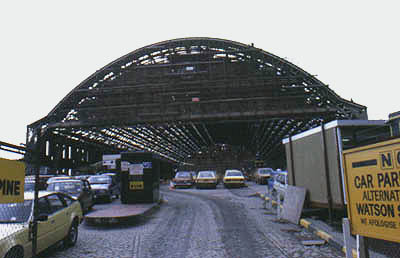 From the Spring of 1976 until the day GMC announced its plans for the development of Central Station as GMEX in 1978, the underlying theme, whenever the Board either talked to the Belle Vue management or asked for ideas and market research, was of a long term future in the conference and exhibition market with possibilities "to be addressed" in the field of popular entertainment. After a few months in post the new team had the terminology pretty well decoded as "you must maximise income whilst minimising expenditure whilst we sort out which facilities may have to be built to bring in the greatest profit for the future". The effect on each area of the complex is dealt with under the individual topic headings but the continuing decline of the complex as a whole had deleterious effects for the areas the Board saw as the foundations of the future. Over a matter of months the "grand plan" became very clear. The area utilised by the banqueting suites and the rather useless gardens which housed some large and fairly unrealistic fibreglass dinosaurs would be redeveloped with a large hotel complex, new exhibition facilities, a conference centre and a major car park which, in one plan, would stretch from the Longsight engine sheds, across Redgate Lane, which would be closed and into the grounds with the boundary wall demolished. Kings Hall would go to be replaced by a new concert venue and the rest of the area would be developed "into an appropriate attraction". The overall plan sounded upbeat and go ahead but, as ever, the devil was in the detail. Whilst THF had, perhaps, the most experienced hotel management team in the United Kingdom, Belle Vue was run by the Leisure division whose Board did not brook interference from elsewhere even within the THF empire. Also, the late 1970s was not a period when British hotel groups covered themselves in glory. Many properties were pushing prices up, reducing refurbishment and, as any expert in hotels and tourism, or any observant traveller for that matter could have attested, there was little flair visible in either the development or day to day running of British hotels. Now the idea of the hotel development was to service the conference and exhibition facilities. At the time most of Manchester's hotels were full Monday to Thursday for forty weeks of the year and the existing exhibition calendar at Belle Vue caused availability problems for miles around and it was observed that the maintenance of the calendar plus additional events, plus a reasonable expectation of new conference trade, would warrant at least 600 bedrooms. Research into the room utilisation made clear what, to any professional, was blindingly obvious: not everyone attending an event had the same accommodation budget. Eating patterns were also changing and the need for a variety of food outlets within the hotel was identified. The obvious answer, backed by research in the USA and Europe, was to build an hotel with a range of bedroom types from two to five star and food outlets from a first class a la carte restaurant through, perhaps, a steak house to fast food outlets. Phil Blinkhorn was in charge of the Belle Vue based research which entailed a few hundred phone calls to venues in the USA and Europe, many of the exhibitors at exhibitions currently at Belle Vue and other facilities, plus contact with exhibition and conference organisers and associations. When he presented his findings, via Chris Hind, to the Board they were rejected out of hand as unworkable and revolutionary. Today such facilities are found in single properties in some of the world's most successful exhibition and conference venues. So, it was determined, there would be two hotels, distinctly different in facilities and décor and without even the possibility of buying a meal in one and charging the account to a room in the other! The writer is unaware if either his or the Board's proposals were shown to anyone at the Hotel Division. Outline planning permission was sought from the City Council and was in process at the time the GMC announced its plans for GMEX. The exhibition facilities were to be expanded and replaced. The idea was to build enough new facilities to house all current exhibitions before refurbishing or replacing the extant halls (better described, in truth, as sheds). When complete (hopefully by 1982), the facilities would be able to house any exhibition the industry could project for Manchester up until 2005. For many years a number of exhibitions had to supplement the space at Belle Vue by taking rooms in City Centre hotels and the end to this inconvenience was one of the most anticipated benefits of the new facilities. 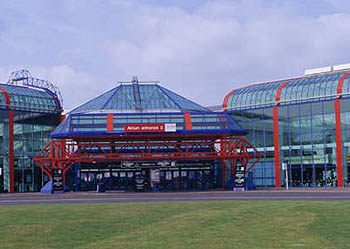 There is absolutely no doubt that the companies which organised exhibitions at Belle Vue held its drawing potential in very high regard. At the time in question, Ivy Holmes managed the bookings and her interpretation of the needs of both exhibitor and visitor was legendary as the best in Britain. With an extremely central location within the population spread of the UK, Manchester offered exhibitors the biggest population concentration outside London and, even with the National Exhibition Centre (above) only 85 miles away, the size of the facility at Belle Vue would have attracted those events which would have been "lost" within the NEC or whose budget would not have stretched to the cost of being in Britain's premier centre. In an attempt to fill currently vacant dates Phil Blinkhorn produced a sales brochure in 1977 and his team were given a brief to bring in new business with an eye to the future. Manchester was and still is (until later in 2001) short of purpose built first class conference facilities. The banqueting suites were used by a variety of product launches, small conferences, product previews and clinics and religious and Masonic meetings. Kings Hall regularly saw major Masonic meetings, religious rallies and the odd motivational conference but none of the buildings involved was ideal. The grand plan was to site a new conference facility alongside the existing banqueting facilities. The size and shape of this was never, to the writer's knowledge, fixed in space. Certainly a wide range of facilities from meeting rooms for 6 to conference facilities, with all audio/visual and presentational facilities for up to 1500, were discussed. Some of the smaller rooms may have been in the hotel facilities and there was some discussion as to the accounting problems this might present (are accountants born without breadth of vision and flair or is it knocked out of them during their training?). The banqueting suites were to be modernised as a rolling programme to ensure the extant business was accommodated and to be ready with new kitchens and interior layouts by the time the conference centre was completed. Kings Hall, as the premier concert venue in Manchester, would be replaced with a new rectangular building capable of handling the ever bigger concert "rigs" and have enough equipment and facility to hold a major conference plenary. Seating figures of around 4000 were discussed and sites ranging from the open space at the side of the Elizabethan Suite to various places within the extant zoo but close to the hotel development, were mooted. One point on which all were agreed was that, whilst each of these properties were to be able to be accessed on its own, all would be linked by some enclosed access, possibly in tunnels. Alongside the exhibition brochure Phil Blinkhorn produced a conference brochure and had some success in bringing in new short term business although, once the zoo closed, the state of the complex hardly inspired prospective organisers when they made their facility visits. The sales team soon learned that the car parks were the best selling point for conferences and business that included car demonstrations, in any form, were eagerly pursued with some success. Of course, in the end, it all came to nought. GMEX went ahead and, from the outset, was not the success envisaged. Business lost when Belle Vue closed never returned to Manchester and the new business gained did not match the potential of the venue. This is not the place to discuss the whys and wherefores but a venue outside the city, with onsite accommodation, excellent parking and public transport might just have retained the historic business and brought in new events. But what would have happened to the rest of the land?
The first impact of the closure of the zoo was on the amusement park. The decision that visitors to the amusements would have to pay an entrance fee has been mentioned in the overview. The staff of the park and the concessionaires rebelled immediately and the Board hastened to placate them by turning a Nelsonian eye to Mike Dudley-Heath's ticketing scheme and they also very quickly installed the Jetstream ride. But what they really wanted was a short term fix to bring a revenue stream whilst making up their collective mind as to the future of about 30 of the 70 acres. 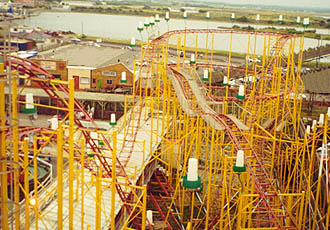 As Sales Manager, Phil Blinkhorn was given the task of finding business to ensure numbers through the gates would not sink to catastrophic levels in the spring and summer of 1978. But what to do? Jetstream apart (seen on the above in its new location at Rhyll), it was made plain that no new rides would be commissioned nor would more than a minimal amount of capital expenditure (five thousand pounds was mentioned) be allowed. In the autumn of 1977 Star Wars was big news. The film was being hyped as the Winter/Spring blockbuster for 1977/78 and Greater Manchester would see a limited release which would guarantee only the Odeon on Oxford Street would show the film for at least the first 15 weeks. Could this be turned to Belle Vue's advantage by bringing extra winter visitors and giving a lead into the spring with an attraction that would probably be saleable for the whole of the summer season?
The first contact was the Manager at the Odeon, would he be interested in a joint promotion if an exhibition could be put together? After consultation with his Head Office, a positive answer was received in Oxford St and communicated to Hyde Road. Belle Vue would mount an exhibition at its expense and "plug" the film and, for Greater Manchester, its exclusive showing at the Odeon. The Odeon, at its expense would "plug" the exhibition in handouts to every filmgoer and a short promo ad before every performance. But first there had to be an exhibition to "plug". Phil contacted Monty Berman, Managing Director of Berman's and invited him for lunch in Manchester to discuss an idea concerning Star Wars. Whether Monty was intrigued, was coming to Manchester anyway or just fancied a day out with a free lunch Phil never found out but by the end of lunch he had an enthusiastic partner. A tentative deal was struck whereby Berman's would take no risk, nor charge any fee until an agreed income level had been reached. Berman's would supply as many of the props, costumes and other items from the Star Wars inventory it had made, supplied and then retained as required to ensure an exhibition that told the story of the film and had the impact of actually having been part of the film. Berman's, the Odeon Group and the UK distributors contacted the studios and various agents and discussions were put in train to have at least some of the human stars at the opening which, it was determined, could be geared to coincide with the opening night in Manchester. Monty Berman made a couple more trips to Manchester and had commissioned a number of designs to exhibit his props and costumes in the best way possible. Throughout, Phil had kept both Chris Hind and Len Barnfather, the Director on the Board responsible for Belle Vue, fully appraised of developments. Indeed, once Monty Berman had agreed to go ahead, Phil had been encouraged to "talk up" the scheme both within Belle Vue and with potential party visit organisers. So it came as something of a thunderbolt when, two days before Monty Berman was due to visit Belle Vue to meet Phil, Chris, Len and representatives of the Odeon, the distributors and other interested parties, including the Evening News, to present his final designs, Len Barnfather cancelled the whole project. He initially gave no indication of why but told Phil to cancel the meeting as "it would not be convenient for any of the Belle Vue staff". Given the Board's history of announcing closures without warning, this set alarm bells ringing around the office block so much so that, by the end of the day, Len Barnfather had to arrange a visit the next day to smooth some very ruffled feathers. Phil cancelled the meeting as instructed, promising to contact everyone again as soon as possible. When Len Barnfather arrived at Hyde Road, he made it plain that the event had been cancelled by the Board. When asked for a reason, he would not elucidate but Monty Berman rang Phil a few days later and made it plain that, whilst he did not have any ill will towards anyone at Belle Vue, he suggested we ask Len Barnfather why Sir Leslie Joseph (Chairman of the Leisure Board) had cancelled the project. Chris Hind did just that and, after some days, the answer came back that there was some history between Sir Leslie and Monty and the bad blood had remained. One can only assume that Monty Berman acted in good faith, spending his company's time and money in the knowledge that the discussions were being reported to the Leisure Board. Why Sir Leslie let things run on for so long we can only speculate but whatever inter company "games" were being played, Belle Vue suffered. And that wasn't the end of the problem of course. The demands of the Board for a revenue stream was reiterated again with the only guidance being "only spend what you have to". ****************************************** Aviation Museum
Within three weeks he had obtained the loan of six airframes for the period from Easter to September 1978 all for only the cost of transport to and from Manchester. British Airways agreed to some sponsorship and the RAF promised a recruitment caravan and various features throughout the summer. The Airport offered some of its archive, Hawker Siddeley Manchester made a similar offer and two of Britain's aviation giants, Harold Bamberg of British Eagle and Freddie Laker (right) offered their personal archives on temporary loan to allow the depiction of the rise of the independent airlines in the UK from 1945. Armed with these offers, a plan of where in the complex the exterior and interior exhibits could be placed, costings for transport, printing, display equipment, insurance and staffing plus an estimate of potential visitor traffic and revenue, Phil met with Chris Hind and Len Barnfather. Within five minutes the idea was shot down in flames. Len Barnfather stated that he had been director of a company which had a controlling interest in the Southend Air Museum which had foundered and been declared bankrupt. Housed in a purpose built venue in the middle of an industrial estate on the edge of Southend Airport, the Museum was a white elephant from day one. Too far from any major conurbation, lacking any public transport to lure people from the delights of Southend's Kursaal amusements and seafront and linked to an airport all the locals wanted closed (though still operational today) the Museum didn't stand a hope in hell. Nothing Chris or Phil said would convince Len Barnfather to present the idea to the Board and Phil thereafter refused to come up with new ideas and concentrated on generating meetings and presentation business. In a way he was proved totally correct with regard to the Aviation Museum as the Manchester Air and Space Museum opened in 1982. Attracting large numbers of individual and party visitors from day one the Museum is now a valued part of the Greater Manchester Museum of Science and Industry and is recognised as a valuable resource and archive for the aviation historianand Phil played a very small but significant part in its early days. 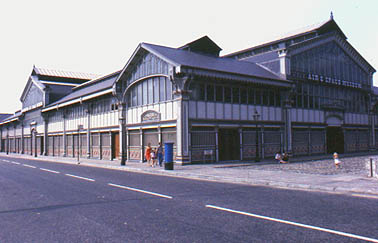 So the amusements struggled through the spring and summer of 1978, eventually to pass out of THF Leisure's control. At the same time Phil's ideas were being rejected, some of the Amusement Park managers visited the USA and Europe looking at new technology and marketing ideas. The hope was that, with a major conference and exhibition venue at the Longsight end of the complex, the Elizabethan Suite would be demolished and that space, plus the remainder of the zoo land would be devoted to new roller coasters and high technology rides. Certainly the market existed. Blackpool and Alton Towers have proved that. The Board were noncommittal but were reasonably pleased with the results from the Jetstream and the matter was put on hold. Could a new Amusement Park have prospered given the proximity of Blackpool and Alton Towers? We will never know but, had the rides, the presentation and the appearance of the facility been kept to a high standard and given the population of the catchment area, the answer is probably yes. One other plan was known of during the period in question to build houses on the zoo whilst retaining the conference, exhibition, banqueting and concert facilities. Well that one turned out to be more than a pipe dream for Belle Vue enthusiasts it turned into their worst nightmare! All the material on this web site is © David Boardman, unless otherwise stated, and may not be copied, downloaded or otherwise reproduced or retransmitted without the written permission of the webmaster. Any contravention of the copyright of others is unintentional and will be corrected immediately when brought to the attention of the webmaster. |
 Phil thought something could be done. The
film, although perceived as American, had been shot in
England and the costumes and sets were supplied by
Berman's of London.
Phil thought something could be done. The
film, although perceived as American, had been shot in
England and the costumes and sets were supplied by
Berman's of London.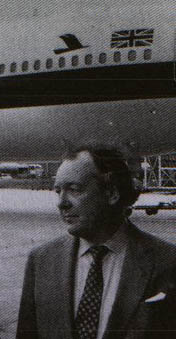 Where next? The problem still lay on
Phil's desk and he turned to his hobby for a
solution. As an aviation enthusiast, he was aware
of the close relationship between Manchester and the
history of aviation and of the many thousands of people
in Belle Vue's catchment area who were, or had been, in
contact with aviation through time in the forces, as
workers in aircraft or component manufacture, through
working at the airport or with an airline, as
enthusiasts or just from flying abroad on holiday.
Aviation has a magic and Phil decided to capitalise.
Where next? The problem still lay on
Phil's desk and he turned to his hobby for a
solution. As an aviation enthusiast, he was aware
of the close relationship between Manchester and the
history of aviation and of the many thousands of people
in Belle Vue's catchment area who were, or had been, in
contact with aviation through time in the forces, as
workers in aircraft or component manufacture, through
working at the airport or with an airline, as
enthusiasts or just from flying abroad on holiday.
Aviation has a magic and Phil decided to capitalise.